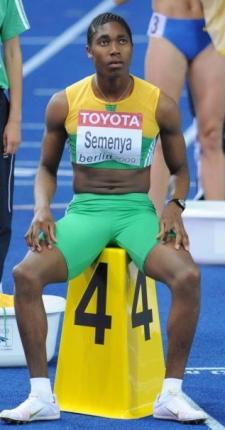Hair above her upper lip. The deep timbre of her voice. A muscular build. Her flatter-than average chest. A growing fixation on these corporeal cues is replacing the cheers that first met teenaged South African athlete Caster Semenya when she took the 800m gold medal at the world championship in Berlin last Wednesday.
Eighteen-year-old Semenya, who grew up in the village of Fairlee in South Africa’s rural Limpopo province, has been forced to undergo “gender verification testing” at the hands of a team that includes an endocrinologist, gynecologist, internal-medicine specialist and a psychologist.
As a long-time member of the queer community, I’ve met a lot of women with deep voices and/or facial hair. In fact, across most people I’ve met I’ve seen a wide range of behaviour and self-presentation across the spectrum of culturally defined “masculine” and “feminine” traits, regardless of whether a person identified as a man or a woman. Or defined themselves in some other way.
One of the competitors who lost to Semenya, sixth-place Elisa Piccione of Italy, complained to media: “to me, she is not a woman.” Those grapes are worse than sour — they’re bitter. And they were only a first wave of a bilious tide of commentary around the world from media sources and internet pundits, ranging from cruel and predictable jokes to demands that the public be allowed to examine her genitals.
Though the debate has been described as concerning fairness to the other female competitors, it reveals much about what happens when the realities of people’s lives butt up against the limits of our socially constructed two-gender-only regime.
What about fairness to Semenya? If the jury in the midst of poking and prodding her determines that she is intersexed, she may be stripped of her title by the International Association of Athletics Federation (IAAF).
Mandatory gender tests for women athletes were discontinued many years ago because of they were deemed fundamentally demeaning. So there may be other intersex athletes competing — often, intersexuality (much like race, class or sexual orientation) is something that you cannot necessarily observe casually).
So essentially, Semenya is being discriminated against because of her non-gender-conforming appearance — and forced to prove whether she is “entirely female.” Watching the results of the Berlin 800m competition, I’m most struck by the ways in which Semenya’s body is similar to those of the other elite female running athletes — rather than the ways it is different.
Their bodies — tall, long-legged, muscular, very little to no breast tissue — are very much alike. I point this out not to objectify these women — rather to point out that while some could argue Semenya’s appearance is quite different from the “average woman” (whatever that means), she and her peers are not quite that disparate at all.
The IAAF’s fixation on Semenya’s biological sex obscures other, non-penalized ways in which genetics may provide advantages to some people and not others. “Top athletes in general have superior genetics that give them an ‘advantage’ over their competitors, whether that’s Michael Phelps’ insanely big feet and double-jointed ankles, or Lance Armstrong’s long femur size,” commented UK-based competitive cyclist Maryka Sennema in The Science of Sport, a blog run by two prominent South African sports doctors.
And while the world of competitive sport may seem hyper-invested in the gender binary, the rest of society has not progressed that much either. Just last week, Mark Steyn wrote mockingly in Maclean’s that “in terms of sexual identity, we’re freer than almost any society in human history, at least in terms of our official validation of our choice to ‘redefine’ ourselves in defiance of biological and physical reality.”
Steyn is admittedly a clown, but he espouses a very common point of view about the inviolability of two and only two genders, assigned at birth and easily identifiable unless there is something “wrong.”
This simple conception belies the findings of developmental geneticist Anne Fausto-Sterling, who wrote back in 1993 in The Sciences that “biologically speaking, there are many gradations running from female to male; and depending on how one calls the shots, one can argue that along that spectrum lie at least five sexes — and perhaps even more.”
The sports world needs to give some serious thought to how it handles natural variation in gender — especially in the case that Semenya is deemed either intersexed or male, despite her own self-identification as a woman. And in lesbian, gay, bisexual and trans circles, this is a good opportunity to consider how we understand and provide support to people — within and outside our communities — who feel they are, or are perceived to be, gender non-conforming.
This can mean being better allies to trans and intersexed folks, but also questioning the ways in which all queers can either benefit or suffer because of our gender identity and self-presentation. After all, one of the key cases fought by the Transgender Legal Defense & Education Fund (TLDEF) last year centred on Khadijah Farmer, a masculine-appearing lesbian who was thrown out of a New York restaurant for using the women’s washroom. TLDEF won the case.
Caster Semenya should not be placed on trial — it’s our society’s outmoded perspective on gender that’s due for an overhaul. That race for equality won’t be won until we’re all free to safely cross the finish line together.

 Why you can trust Xtra
Why you can trust Xtra


